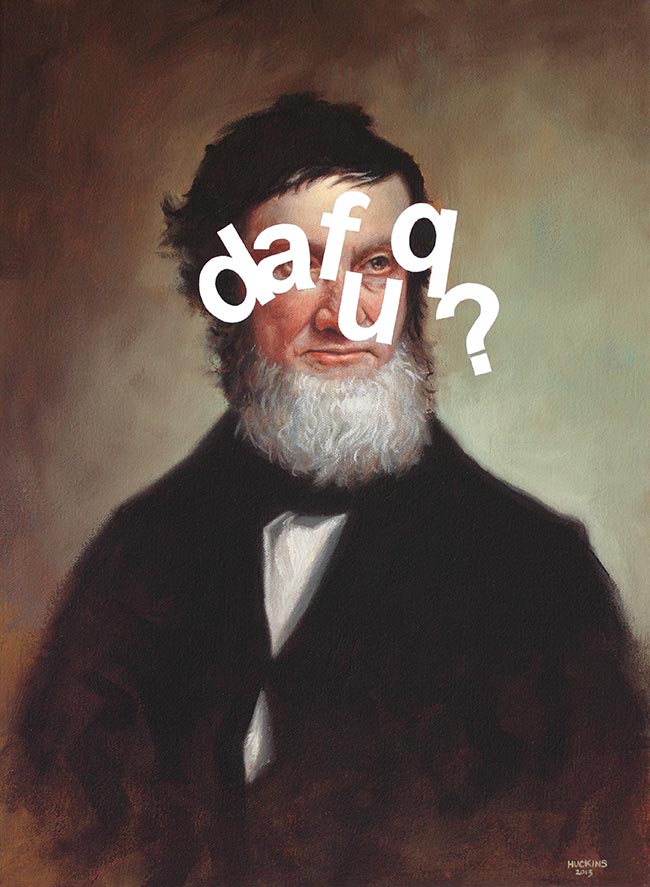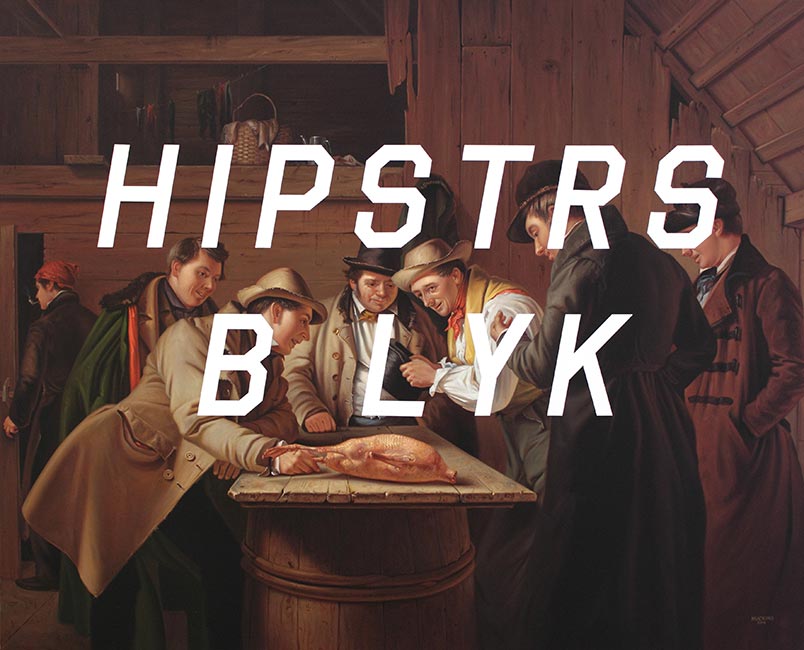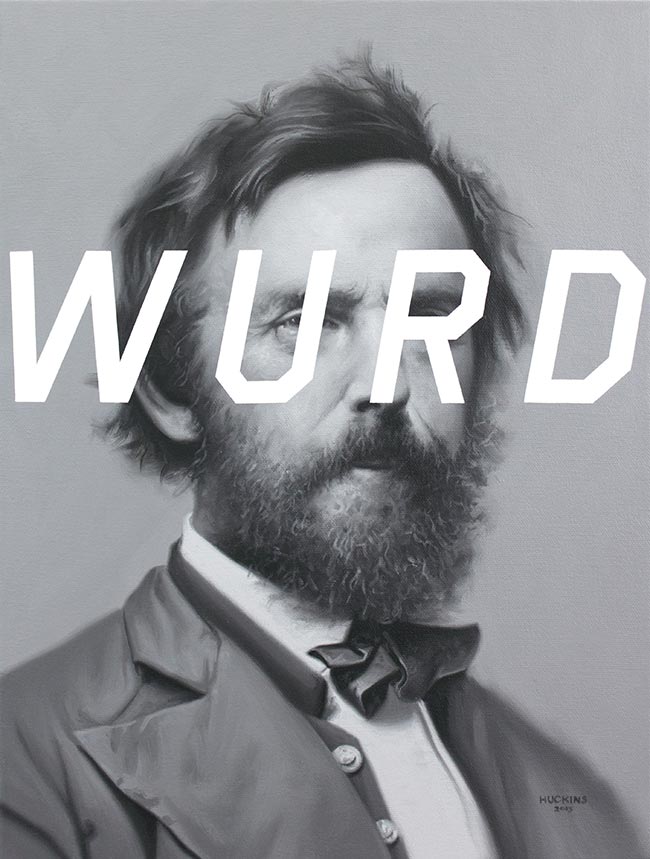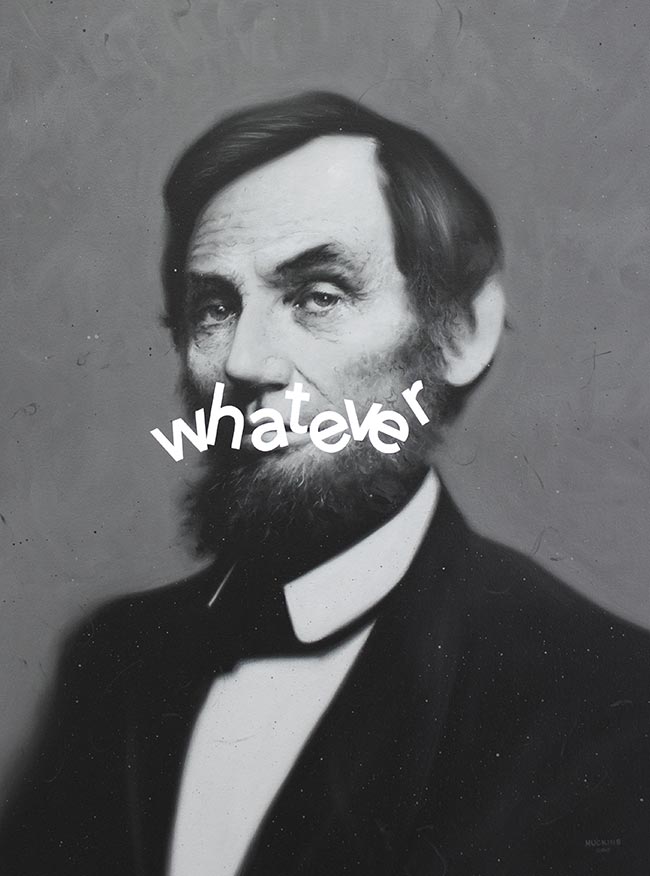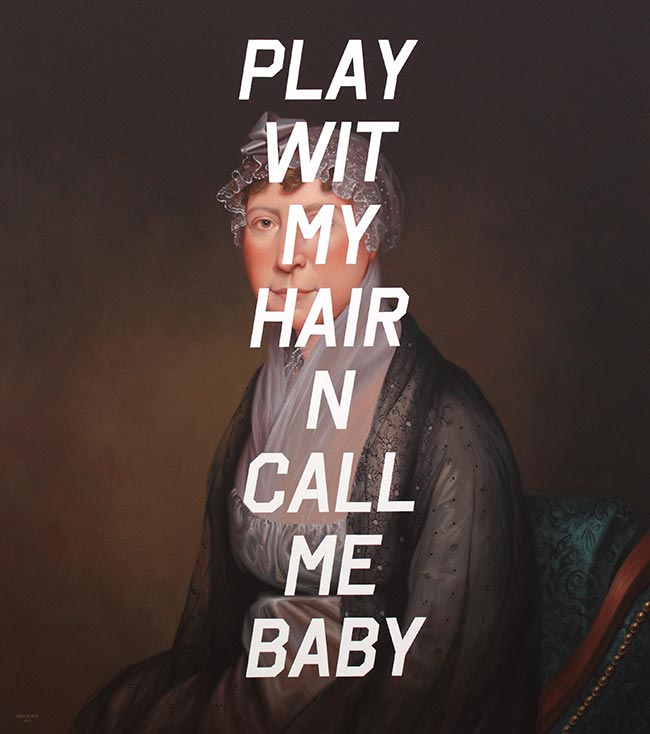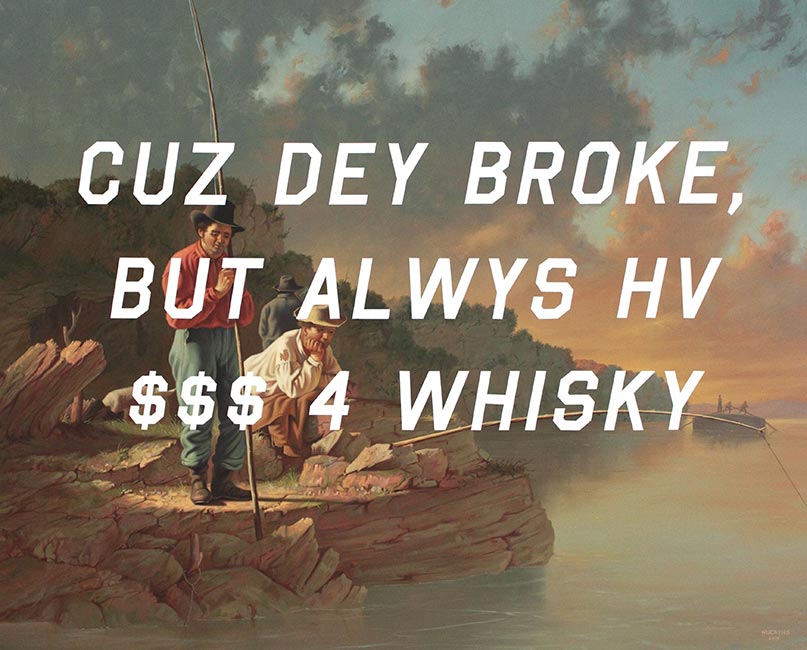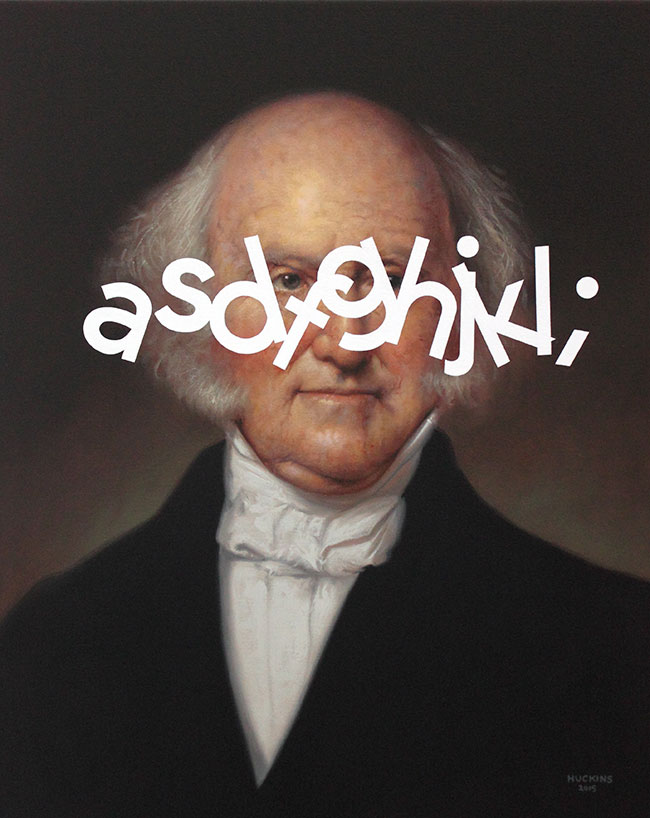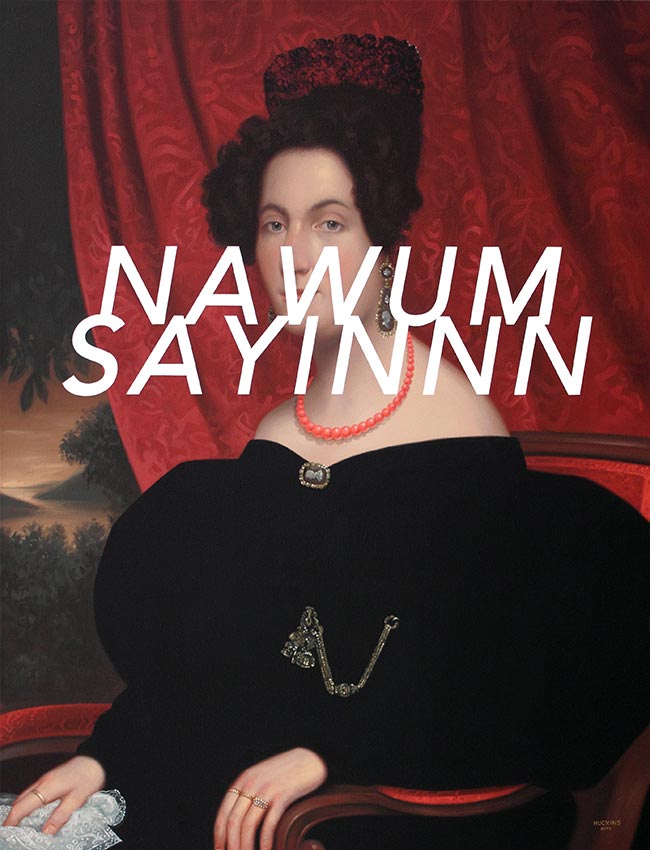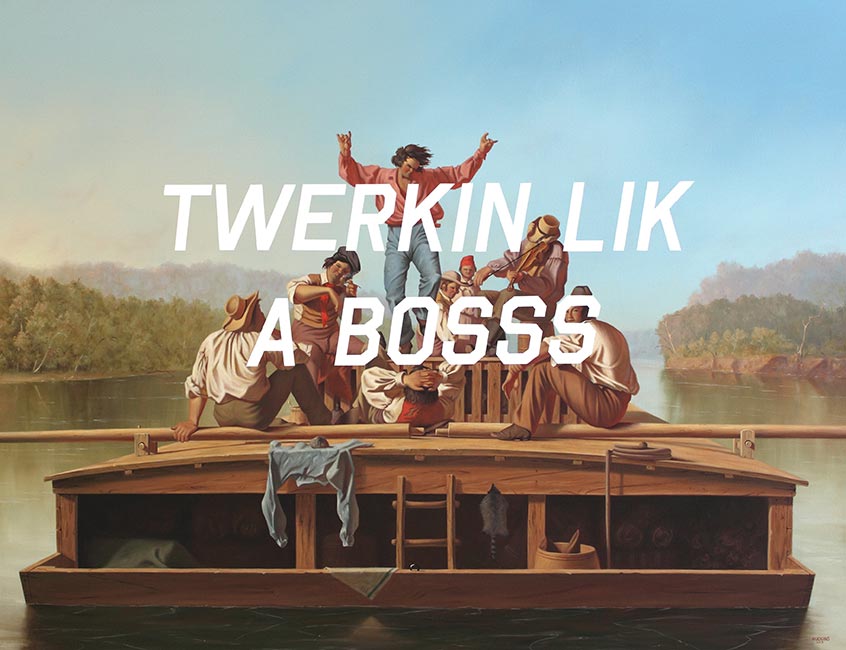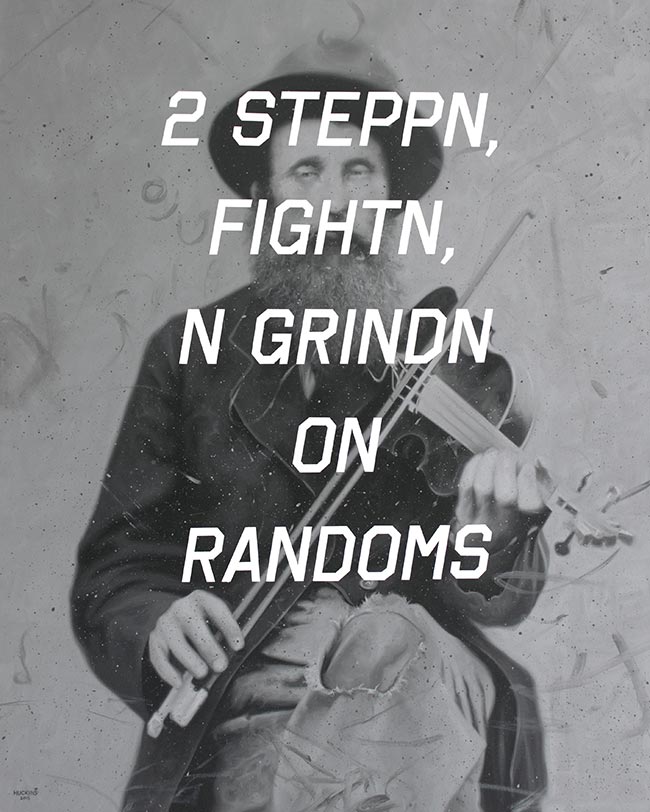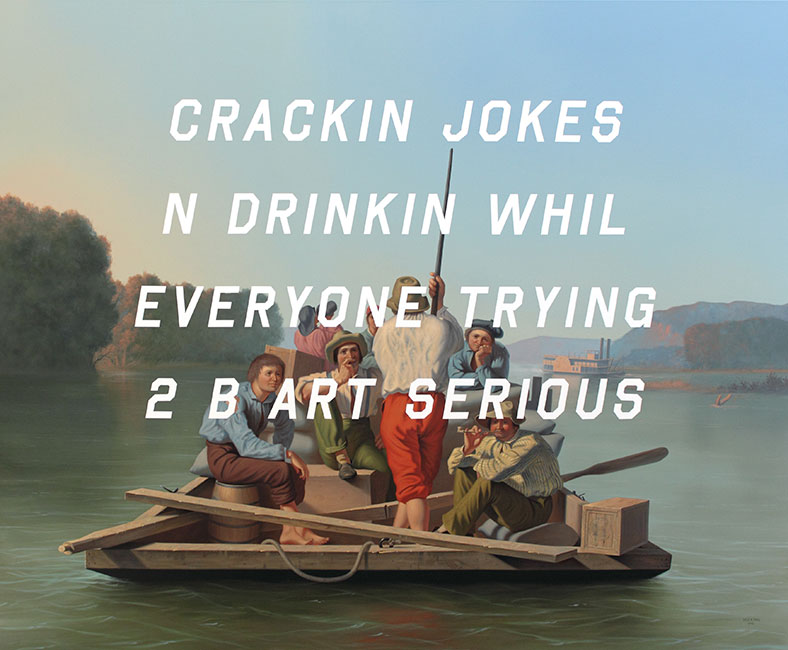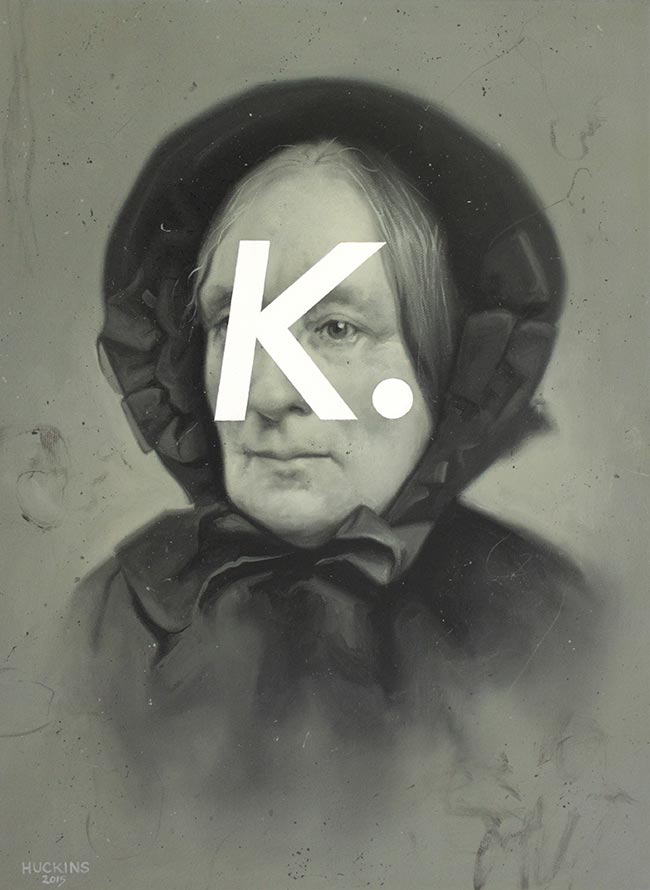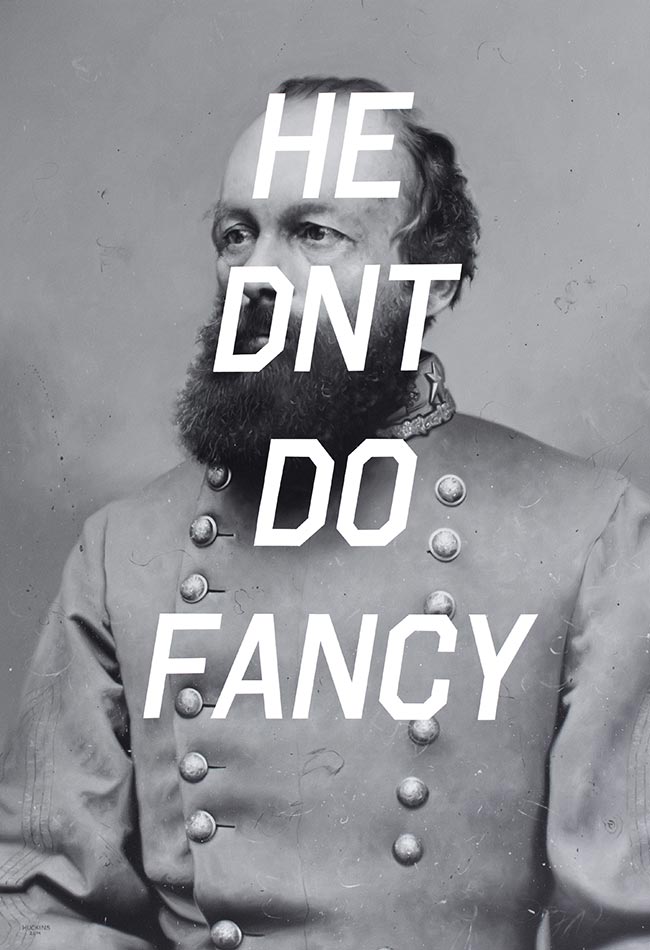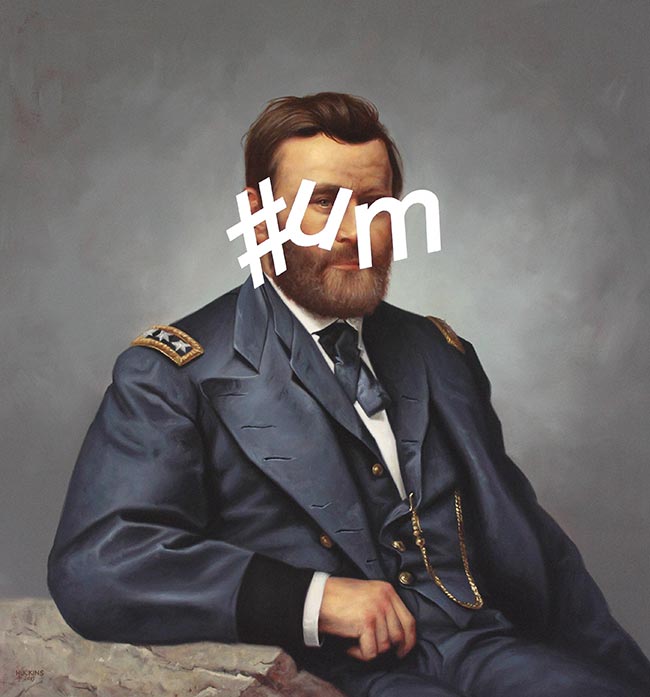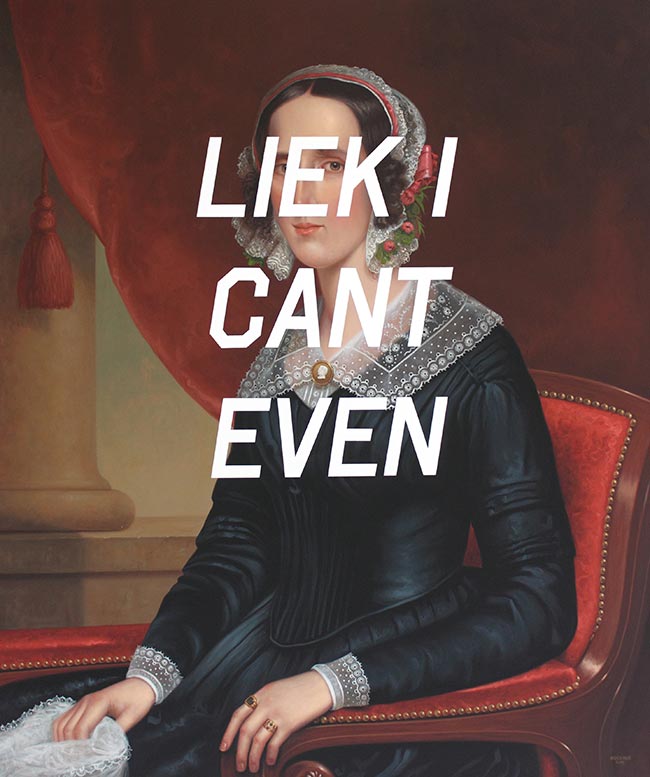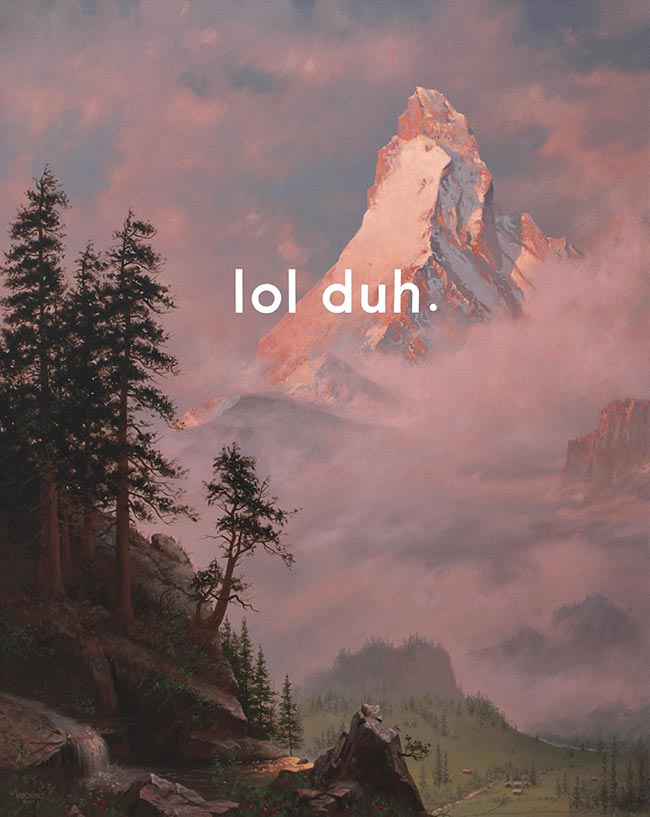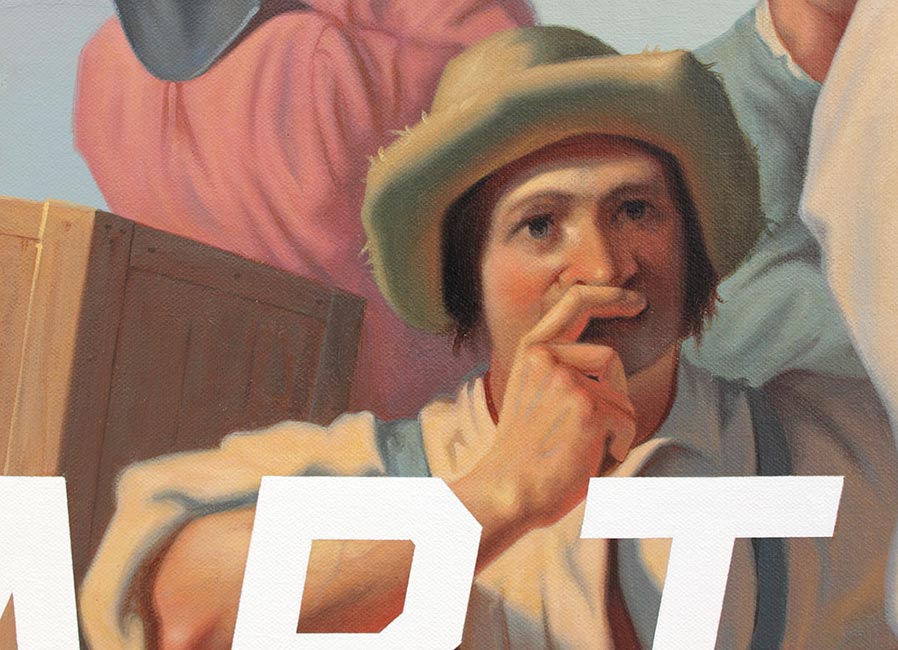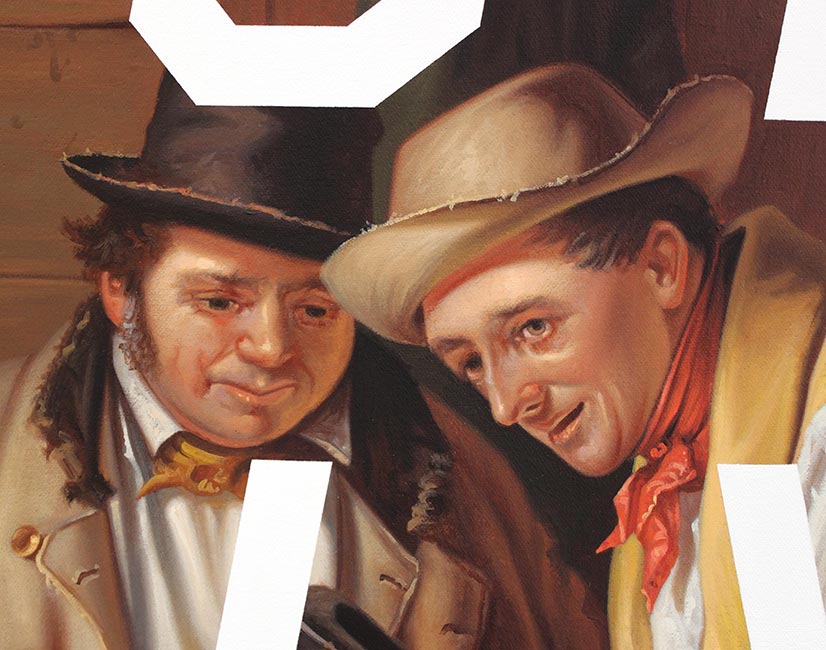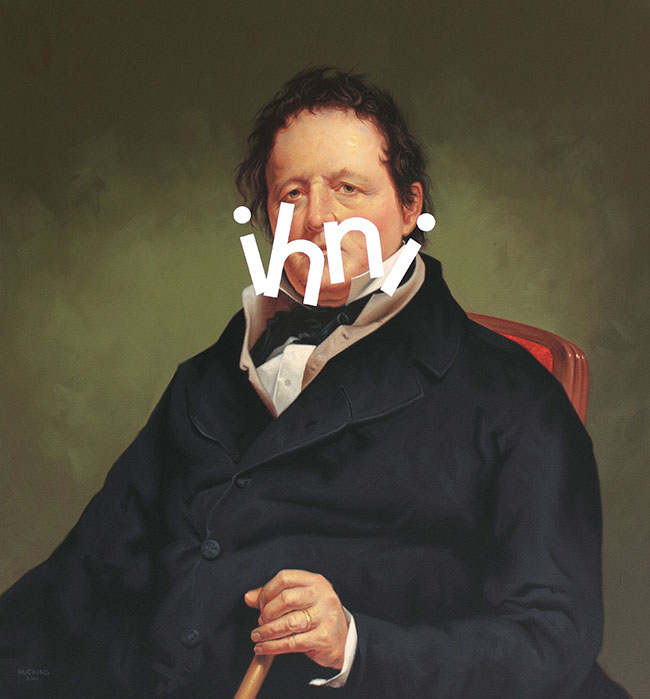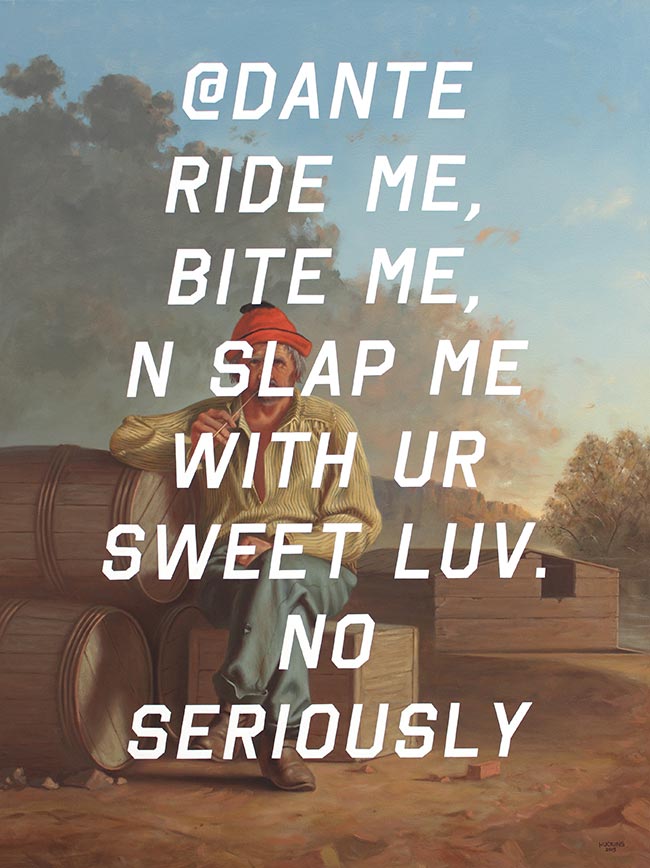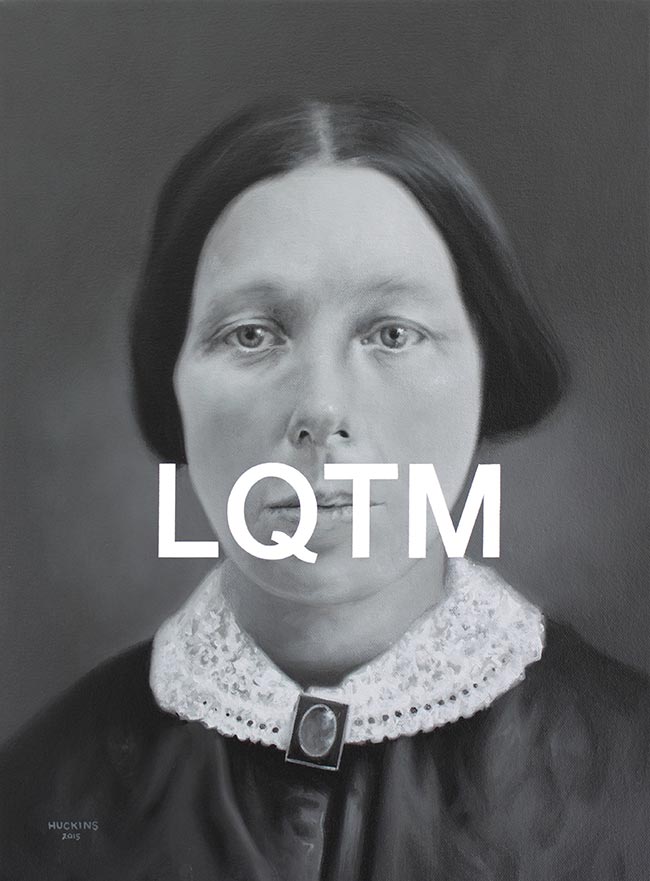Shawn Huckins’ paintings explore concepts surrounding the impact that contemporary technology is having on changing the way in which we communicate. Focusing on era’s of American history for which he has a distinct nostalgia, Huckins recreates classic images from the the past and then transposes snippets of shortened and abbreviated pieces of communication he stumbles across while trawling the internet. His work draws attention to the acronyms and text speak that have become the norm through our use of mobile devices and social media, and he contrasts these with images from a simpler time, when people, somewhat ironically, seemed more ‘connected’ and real life interaction took precedence. With technology becoming a more inescapable part of our lives with each passing day, the conversations that Huckins’ work open up, give us pause for thought and encourage us to set aside our mobile phone or iPad and to take a quiet moment to contemplate the future of our communication with one another and the basic degradation of language itself.
Shawn was born in 1984 in Laconia, New Hampshire. He graduated from Keene State College in 2006, with a Studio Arts major. Shawn will be unveiling his latest solo exhibit entitled, ‘The American _tier’ on 17th April at Goodwin Fine Art.
WOW x WOW caught up with Shawn as he was preparing the finishing touches for his show, to get more insight into the work and thoughts of this intriguing young artist.
Hi Shawn, thanks very much for joining us, we really appreciate you taking the time. To get us started, can you tell us a little about your background, touching on anything you feel relevant to story of Shawn Huckins the artist?
Thanks for having me! Well, as it seems with every artist’s story, I loved to draw as a kid. I drew everything a boy would be interested in: my favorite sports heroes, video game characters, Disney cartoons. I had these little sketch books and mostly used colored pencils to compose my drawings. I really enjoyed it. At age nine, my grandmother passed away and I was given her slightly used oil painting set. I remember how good the oil paints smelled when I opened up the box. That, however, was my only fond memory of that experience. I had a terrible time using this new medium…I had no idea what I was doing. I got frustrated, set it aside, and went back to drawing. I didn’t get back into painting until my later high school years and going hardcore in college. My instructors were a big influence in re-introducing the medium to me and I fell in love with it. Today, I exclusively paint, but with acrylics and not oils.
What does your studio look like?
I have a beautiful little studio that was formally the spare bedroom. Large windows and plenty of light all day. It faces the east and located on the third floor, so I see the beautiful sunrise every morning. It’s also a tidy studio. I do have my messy moments when I’m really into a painting or have deadlines. But the majority of the time it’s kept pretty clean. I tend to focus better and have a clearer mind when the studio is organized.
You have an upcoming solo exhibit entitled ‘American _tier’, which opens on 17th April at Goodwin Fine Art. Please give us some idea of what we can expect from your new body of work and any evolution you have seen your work go through with the making of this new series?
With the newer body of work, I’ve been experimenting more with the text and it’s composition in relation to the subject. Typically, I center justify the text with the blocky font style, as it’s easier to mask off with tape. In the early stages, when I draw the image onto canvas, the letters are also drawn and masked off with tape before any painting beings. This retains the vibrant white of the original canvas. However, I’ve been experimenting with different font styles and positions. Also, with ‘The American __tier’, landscapes are more prevalent than my previous ‘The American Revolution Revolution’ series which are all formal portraits.
What responses do you hope the ‘American _tier’ show will arouse from it’s audience?
The initial response I hope to receive are ones of laughter…but laughing with me and not at me. This series is suppose to make people chuckle and have a laugh. While some others really dig into the underlying message which can be found in my artist statement. I also like to hear that people appreciate the technique. I get a lot of questions about if my work is a reproduction (printed) or digital version of the original. So to have viewers see my work in the flesh and realize they are original acrylic on canvas paintings is very satisfying.
In your work, contemporary life and the technological revolution is contrasted with the simpler life from past eras in American history. Can you give us some insight into your inspiration for highlighting these distinctions and how you go about choosing your subject matter?
My previous life must have been in the 18th century. Since elementary school, I have been so fascinated with American history between the Revolution and The Frontier days. Maybe I’m drawn to the simplicity of that life. I grew up in New England, so I was engulfed by the architecture and traditions from the founding days. And since moving out west to Denver, the culture of the Frontier and cowboys is very prevalent here. I generally choose my subject matter based on how the original painting was technically done in addition to what the subject actually is. I try to find similar artists that have the same sensibilities. Choosing which text to marry with an image is also a process. I research images separately on one day and the next research (troll) for text to use. Factors such as if the subject is male or female, how they are positioned, what smile or smirk they have all attribute to choosing the right text.
Is the technological age something that worries you?
I don’t lose sleep over it, but it is worrisome. We have become so dependent on technology that we have forgotten to do simple things. My work is about how we have forgotten to have intelligible, in-depth conversations with our peers. Everything has been shortened and abbreviated out of convenience to make things quicker and easier, but the emotion and human psyche has been lost. Technology is great and it’s saving lives everyday whether it be in the medical field or driving a car. Unfortunately, technology can also distract us from real-life moments.
The internet is clearly a source of inspiration for you. Apart from enabling easy accessibility of source material, what are some of the other ways in which the net has changed your creative practices? For better or worse.
The internet is definitely an invaluable resource…I think not only for me, but for a lot of artists. With the ease of making a website, it is very easy to see mounds of new artists and their work. Additionally, it’s really nice to be able to view the permanent collection, for example, of the Museum of Fine Arts in Boston while I’m in Denver. Finding inspiration is literally a point and click away.
The down side: it can be very distracting and can make one lose focus. I’m a victim of this and when there are challenging parts, I’ll go to my phone for a distraction versus tackling the difficulty. I’m getting better at this to try to remove myself from checking emails several times a day, scrolling Instagram, etc. It’s very easy to watch an entire series on Netflix…and avoid everything.
Humour is an integral part of what you do. Please give us a brief insight into this side of your work?
I think it all comes from not being a serious kind of guy and it’s in my personality to avoid drama and emotions. I don’t feel the need to incorporate deep dark emotions in my work. In college, I had a difficult time during critiques because my professors where trying to milk me for more in-sight on a particular painting and I just couldn’t produce the in-depth explanation. Sometimes a still life is just a still life. Although there is a deeper meaning behind language in my paintings, humor is a characteristic I try to go for in my work.
Nostalgia plays an important role within your intentionality regarding message. Can you discuss the nostalgic part of your personality and what elements of it you choose to portray in your artwork?
The nostalgic parts in my work would be within the subject matter and not the text. It’s about comparing two eras: the founding and exploratory years of our nation versus our technology driven society. It’s easy for me to idealize those centuries past life as being less chaotic and simpler. I visualize community and relationships being stronger as there were no technological distractions. People were the distraction. I would have loved to have been part of those times….especially post revolution. I’m attracted to their architecture, clothing, music. So it’s fun to paint those subjects since time machines haven’t hit the market yet.
It’s no secret that you’re a huge fan of Ed Ruscha. Aside from his obvious influence, are there any other text based artists who you particularly admire?
Yes! Love Ruscha. Every since I saw his work in an art history book in college, I was hooked. Regarding the previous question, his early work is very nostalgic and reminded me of parts of my childhood. For example, his Standard Station paintings remind me of my grandfather who passed away two years ago. He used to build and restore antique cars in his garage and the sight and smells of oil/gasoline and paint fumes brings back the times when I would sit in the garage and watch him…and probably annoy. Anyways, I enjoy the work of Graham Gillmore because he has the quality in which I wished my brain function. His paintings are a combination of text and abstraction which I find visually appealing.
As you mentioned earlier, many people mistakenly conclude that your images have been pieced together digitally. What is it that compels you to paint your subject matter and why do you think that painting continues to remain a relevant art form, despite many academicians and critics declaring it’s death years ago?
Painting is such an intimate process. Lots of work goes into each and every painting. Painting is definitely not dead, but I can see how things become fads in the art world that may diminish the ‘seriousness’ behind painting. I enjoy painting because I enjoy using my hands to create something whole and finished. I come from a long line of carpenters and woodworkers, so working with my hands is in my blood. Painting is relevant because it’s a relic of the individual that created it. It’s recorded history.
What’s next for Shawn Huckins?
I see lots of experimentation in my future…trying different techniques, using different mediums, etc.

